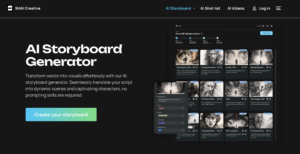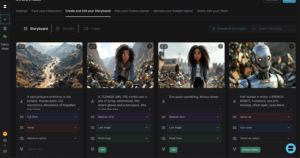Everything you need to know about FrameForge in 2025 starts with its Emmy-winning approach to virtual filmmaking. FrameForge transforms storyboarding into optically accurate previsualization, offering filmmakers a virtual studio environment that, while powerful, lacks the streamlined efficiency of modern AI storyboard generators like Shai.
What is FrameForge?
FrameForge is an Emmy and Lumiere Award-winning previsualization software that creates optically accurate virtual film studios for directors, cinematographers, and VFX supervisors. Developed by filmmaker Ken Schafer and Innoventive Software, the platform enables users to explore shots, test production scenarios, and create data-rich storyboards using simulated cameras, actors, and objects in photo-accurate 3D environments, serving productions from independent films to major studio blockbusters.
What is FrameForge Used For?
- Virtual Location Scouting – Test shot feasibility before arriving on set
- Complex Camera Movement Planning – Previsualize crane, dolly, and Steadicam shots
- Stereographic 3D Production – Plan and test 3D filming setups
- Production Problem Solving – Identify and resolve technical challenges pre-shoot
- Department Communication – Create detailed boards with technical specifications
Virtual Location Scouting and Shot Testing
Everything you need to know about FrameForge uses in 2025 begins with its virtual scouting capabilities. Production teams import location measurements and create accurate 3D environments, allowing directors to experiment with shot compositions before expensive location days. The software’s optically accurate cameras replicate specific lens choices, showing exactly what the real-world camera will capture.
However, this technical accuracy comes with significant complexity. Creating accurate virtual sets requires extensive manual input of measurements, object placement, and environmental details. Many users report spending hours building virtual locations, time that could be spent on creative development rather than technical recreation.
Complex Camera Movement Planning
Cinematographers utilize FrameForge to previsualize elaborate camera movements involving cranes, dollies, and specialized rigs. The software’s physics engine simulates real-world constraints, helping teams identify potential equipment conflicts or impossible shots before arriving on set. This capability has proven valuable for productions ranging from Downton Abbey to Marvel’s Agents of SHIELD.
Despite these capabilities, the learning curve remains steep. Operating virtual cameras requires understanding both real-world cinematography principles and FrameForge’s complex interface. Many professionals find themselves investing in extensive training or hiring specialists, adding unexpected costs to pre-production budgets.
Production Problem Solving and Technical Planning
FrameForge excels at identifying potential production challenges through virtual testing. The platform’s “proven track record of saving productions time and money through virtual testing” earned its Technical Achievement Emmy. Teams can test lighting setups, verify sight lines, and ensure shot feasibility without expensive on-set experimentation.
Nevertheless, this problem-solving approach often creates new challenges. The software’s focus on technical accuracy can overshadow creative storytelling. Directors report becoming bogged down in technical details rather than focusing on narrative flow and emotional impact.
FrameForge Features You Need to Know in 2025
- Optically Accurate Virtual Cameras – Match any real-world camera and lens combination
- Individual Lighting Control – Multiple light sources with real-time overlapping shadows
- Depth of Field Simulation – Accurate focus pulling and bokeh effects
- Green Screen Integration – Plan and test VFX shots with virtual compositing
- Stereographic 3D Tools – Award-winning features for 3D production planning
How Much Does FrameForge Cost?
FrameForge offers two main editions with significant price differences:
- Core Edition: Starting at $799 one-time purchase or $24.99/month subscription
- Pro Edition: Professional features at premium pricing (contact for quote)
- Educational Discounts: Available for qualified institutions
- Expansion Packs: Additional actors, props, and locations sold separately
FrameForge Pricing: What You Need to Know in 2025
Everything you need to know about FrameForge pricing in 2025 reveals a costly investment for comprehensive functionality. While the Core Edition provides basic features, professional productions typically require the Pro Edition plus multiple expansion packs, pushing total costs well beyond initial pricing. The one-time purchase option appeals to some, but lacks the continuous updates and improvements found in modern subscription models.
The hidden costs extend beyond software licensing. FrameForge’s complexity often necessitates dedicated operators or extensive training programs. Productions budget thousands for workshops, tutorials, and specialized personnel, making the true cost of implementation far exceed the software price alone.
Company Story
FrameForge emerged from filmmaker Ken Schafer’s frustration during the 1988 Writer’s Strike. Previously successful with scriptwriting software, Schafer recognized that existing storyboard solutions merely addressed the “I can’t draw” problem without improving actual shot preparation. His vision centered on creating a true virtual film studio that would revolutionize pre-production planning.
Innoventive Software launched FrameForge as the industry’s first optically accurate previsualization tool accessible to independent filmmakers. The software democratized capabilities previously exclusive to big-budget studio productions, where commercial previs could cost tens of thousands per minute. This accessibility earned recognition from industry professionals and technical achievement awards.
The platform’s evolution reflects both technological advancement and market challenges. While earning prestigious awards including a Technical Achievement Emmy and Lumiere Statuettes, FrameForge struggled with changing distribution models and increasing competition. The company’s commitment to technical accuracy over user accessibility has defined both its strengths and limitations in the modern marketplace.
Why Use AI Storyboard Generator Software?

Shai’s intuitive interface where users can upload a script and generate visual storyboards, complete with scene sequencing, shot duration, and voiceover options — all in one platform.
AI storyboard generators represent the evolution of pre-production planning, moving beyond technical simulation to creative enablement. These modern tools understand that storyboarding serves narrative communication, not just shot verification. By automating technical aspects, AI solutions free creators to focus on storytelling, pacing, and emotional impact.
Moreover, AI-powered platforms dramatically reduce the time investment required for professional storyboarding. Instead of building virtual sets from scratch, creators describe their vision in natural language. The AI interprets these descriptions, generating appropriate visuals that capture intent without requiring technical expertise or 3D modeling skills.
Furthermore, modern AI storyboard generators prioritize collaboration and iteration. Cloud-based architectures enable real-time sharing, instant feedback integration, and version control. This accessibility transforms storyboarding from a specialized technical process into a creative dialogue between all production stakeholders.
Additionally, AI solutions address the accessibility gap in professional pre-production. While tools like FrameForge require significant training investment, AI generators work intuitively with creators’ existing skills. This democratization enables independent filmmakers, content creators, and small production companies to achieve professional results without specialized expertise.
Why Look for an Alternative?
- Steep learning curve – Requires extensive training to use effectively
- Time-intensive setup – Building virtual sets takes hours before creating shots
- Outdated interface – Complex menus and workflows from previous decades
- Limited creative focus – Technical accuracy overshadows storytelling needs
- High total cost – Software, training, and operator expenses accumulate quickly
- No AI assistance – Manual creation of every element and shot
- Poor collaboration tools – Difficult to share and gather feedback efficiently
- Expansion pack dependencies – Basic package lacks essential assets
Overwhelming Technical Complexity
Why look for a FrameForge alternative – what you need to know in 2025 centers on its intimidating complexity. New users face hundreds of controls, settings, and parameters before creating their first shot. The software assumes extensive knowledge of both cinematography and 3D software conventions, alienating writers, producers, and other non-technical creatives from the storyboarding process.
Time-Consuming Virtual Set Construction
FrameForge’s requirement to build detailed 3D environments before storyboarding creates significant workflow bottlenecks. Productions report spending days constructing virtual sets with accurate measurements, furniture placement, and architectural details. This front-loaded time investment delays creative exploration and often exceeds the time saved during actual production.
Creative Process Disruption
The software’s focus on technical accuracy frequently disrupts creative flow. Directors describe losing narrative momentum while adjusting virtual camera heights or configuring lens parameters. This technical emphasis transforms the intuitive process of visual storytelling into a complex technical exercise that distances creators from their artistic vision.
Why Choose Shai?

Shai storyboard view showing AI-generated frames from uploaded script
What you need to know about FrameForge alternatives in 2025 leads directly to Shai’s revolutionary approach. While FrameForge requires hours of virtual set construction, Shai generates complete storyboards from simple script uploads. The AI understands scene descriptions, automatically creating appropriate environments without manual 3D modeling.
Shai eliminates FrameForge’s steep learning curve through intuitive design. Creators work with familiar concepts – scripts, shot descriptions, and visual references – rather than wrestling with complex 3D software. This accessibility empowers entire production teams to contribute to visual planning, not just technical specialists.
The platform’s AI-powered efficiency transforms pre-production timelines. Instead of days building virtual sets, teams generate complete storyboards in minutes. Real-time adjustments allow instant refinement of shots, angles, and compositions without rebuilding entire scenes. This speed enables creative exploration rather than technical problem-solving.
Furthermore, Shai’s modern collaboration features surpass FrameForge’s isolated workflow. Cloud-based sharing, integrated feedback systems, and version control create seamless team communication. Stakeholders review and comment on storyboards from any device, accelerating approval processes and ensuring alignment.
AI storyboard generators like Shai recognize that successful pre-production balances technical planning with creative vision. The platform provides professional-grade outputs – detailed PDFs, shot lists, and animatics – without sacrificing the spontaneity and flow essential to storytelling.
Conclusion
Everything you need to know about FrameForge in 2025 reveals a powerful but increasingly outdated approach to pre-production planning. While its technical accuracy and virtual studio capabilities earned industry recognition, the platform’s complexity, time requirements, and creative limitations make it unsuitable for modern production workflows.
For filmmakers seeking efficient, creative-focused storyboarding, Shai Creative offers the next generation solution. By combining AI intelligence with filmmaker-friendly interfaces, Shai delivers professional results without the technical overhead that defines FrameForge’s experience.
Ready to experience the future of intuitive storyboarding? Sign up for Shai today and join thousands of creators who’ve discovered that powerful AI storyboard generators can enhance rather than complicate their creative process.